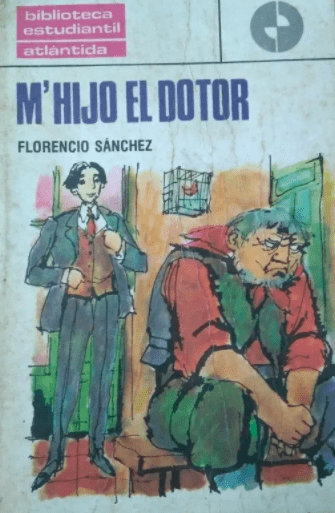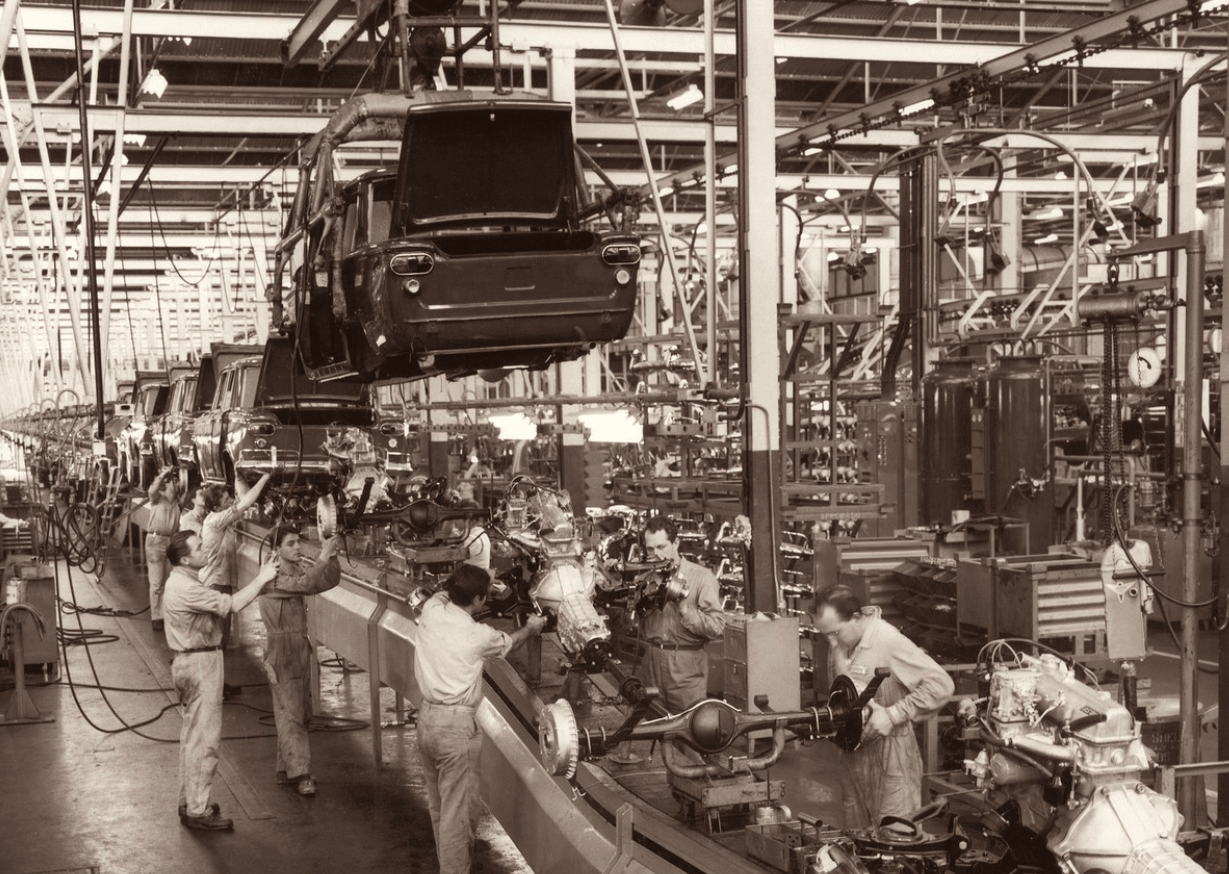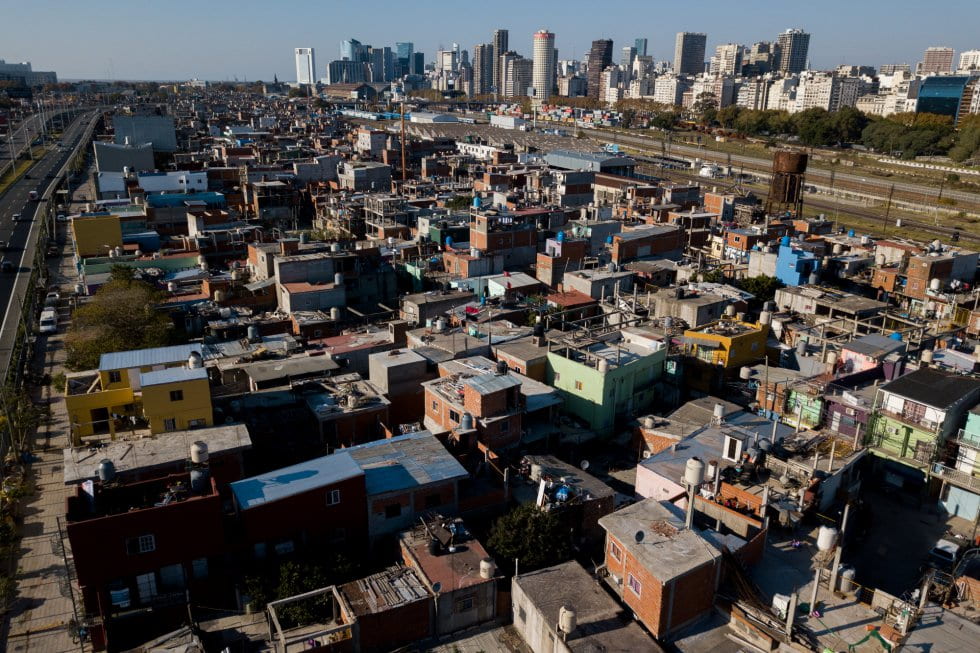A Perfect Labyrinth? The Last Half Century in Argentina
I remember reading in high school the play by Florencio Sánchez, “M’hijo, el dotor” [My son, the doctor], the story of a peasant’s son who studies at the university and becomes a doctor. My great-grandparents Antonio Carassai and María Pierucci arrived in Argentina the same year Sánchez wrote the play, 1903. Like many others, their children and grandchildren experienced firsthand the history of social mobility in Argentina.

M’hijo el Dotor
During a good part of the 19th century and the first three decades of the 20th, Argentina experienced one of the highest economic growth rates in the world thanks to the expansion of agricultural production and exports that provided economic resources to the country. This process was not evenly distributed throughout Argentina and had social costs. The popular and working-class sectors, in general, didn’t have access to housing. The famous “conventillo,” SRO’s, collective urban dwellings shared by several families, was a sign of that weakness.
This relative economic prosperity enticed a massive influx of immigrants who crossed the ocean to settle in Argentina, in a higher proportion than in the rest of the countries of the subcontinent—an indicator that individual and collective progress was relatively more likely there than in other latitudes. However, economic prosperity was not accompanied for much of this period by political modernity. It was only after the sanction of the Sáenz Peña Law, in 1912, that Argentine men were able to elect their rulers in votes that were not determined by electoral fraud. But even with these political shortcomings, the new generations had certain expectations of reaching better positions than their parents.
The Argentina of seemingly eternal prosperity was suddenly interrupted by the worldwide depression of 1929. However, a policy of import substitution industrialization—a new pattern of accumulation—led to considerable economic recovery of the economy. Rapidly at first and modestly later, this pattern made prosperity possible for many, regardless of social class credentials. Tourism, for example, was increasingly more accessible, and beach resort cities along the coast of Buenos Aires province would receive visitors from every social class. That does not mean that the benefits of this progress were distributed equally throughout the entire social scale, but by the end of the 1960s Argentina was the most developed country of Latin America, whether considering level of literacy, minimum wages, level of poverty, access to education or the unemployment rate. In those years, the Italian sociologist Gino Germani, founder of the sociology department at the University of Buenos Aires, used to say that, in the world context of that time, Argentina did not have a serious problem. The problem, the historian Tulio Halperin Donghi added ironically years later, was that Argentines ignored that.

The Fiat factory in 1963, an example of import substitution in its best moment. Source: CLARÍN.COM
With its pluses and minuses, in relative terms to the region, it can be said that that Argentina, first turned outwards exporting agricultural products and then oriented inwards substituting imports, was a successful nation. That is the image that emerges from the juicy dialogue recently engaged in by historians Pablo Gerchunoff and Roy Hora, published by Siglo XXI Press in 2021 under the title of La Moneda en el aire. Conversaciones sobre la Argentina y su historia de futuros imprevisibles. That success seems even more convincing when contrasted with the country’s performance in the last half century, in which the history of relative prosperity of yesteryear is almost reversed.
From 1975 to the present, Hora reflects, “It is difficult to find examples of nations that have regressed as much as Argentina” (p. 229). Simplifying this bitter history, it could be said that since the mid-1970s, Argentina navigated waters that made it move between two shores: on the one hand, a price system crisis (in the extreme, hyperinflation); on the other, a debt service crisis (at the extreme, default). Both crises were and are related, as shown by the fact that much of what the country did to get out of (or avoid falling into) the first—such as the Convertibility Law in the 1990s, which tied the Argentine peso to the US dollar—sooner or later brought it closer to the second. Currency convertibility, like other economic regimes implemented before (1977-79) and after (2016-18), depended acutely on the inflow of foreign capital, a variable that escapes the will of governments and always ends up injecting instability to the macroeconomic balance. For the great majority, in the best of cases, this instability translates into their salary’s loss of purchasing power or, in the worst of cases, unemployment.
Between crisis and crisis, Argentina experienced moments of growth that aroused the optimism of locals and the international community. But those moments were soon revealed as unsustainable over time and led to increasingly devastating crises. It is true that neither the inflationary processes nor the debt crisis have been exclusive to Argentina. We don’t have to leave the region to see that other countries went through similar problems, even more or less at the same time. However, in relative terms, the way in which these problems impacted the social and economic indicators of the different nations leaves Argentina among the countries that poorly coped with them. To cite two examples, one social and the other economic: in decades in which most of the countries managed to improve their poverty rate, Argentina worsened it; and in a Latin America that, except for Venezuela, finally managed to control inflation, Argentina today (and for several years) has one of the highest inflation rates on the planet.
Upstairs, downstairs
It would seem that growth in Argentina is what happens between one crisis and another. But this idea of a cycle that repeats itself with persistent tenacity should not prevent us from seeing that, in social terms, the general process is not circular but regressive. After each crisis, the country becomes poorer and the take-off that follows must start from a more broken social framework than the one that served as the basis for the previous cycle. This performance, in political terms, is not attributable to a single party nor to the government in power. Between 1973 and the present, democratic (1973-1976/1983-present) and dictatorial (1976-1983) regimes alternated. In the democratic years, different political forces governed: Peronism (1973-1976; 1989-1999; 2002-2015; 2019-present), Radicalism (1983-1989), and predominantly non-Peronist alliances, of which Radicalism was a part (1999-2001; 2015-2019). Contrary to what happened at the beginning of the 20th century, Argentina at the beginning of the 21st century combines a democratic and progressive political system, which gradually expands civil and social rights, with a mediocre and tendentially exclusionary economic performance, which conspires against the effective materialization of the rights sanctioned by politics.
As a result of this process, the social structure of Argentina also experienced significant changes. In the early 1970s, two of the characteristics that distinguished Argentina from many of the countries in the region continued to be its vigorous middle classes and its unionized working class. Although since the 1940s the electoral preferences of the former turned mainly towards non-Peronism and those of the latter remained mostly loyal to Peronism, post-war Argentina had offered enough benefits to both for avoiding desiring a radical change regarding the past. The best proof of this is that the economic project that Perón had in mind in 1973 and Raúl Alfonsín in 1983, beyond the rhetoric to which they appealed, did not differ substantially: both bet on an agreement between capital and labor in a semi-closed economy that would protect full employment, with a strong role of the state in the distribution of resources and administration of welfare.
The changes that occurred in the world economy in the 1970s caused that post-World War II consensus, which was able to sustain itself for a few more years thanks to the availability of abundant and cheap credit, came to a dramatic final at the end of the 1980s, when Argentina’s debt crisis was followed by a hyperinflationary crisis and Alfonsín (1983-1989) had to bring forward the end of his term. Hyperinflation engraved an indelible mark in social memory. People who wanted their money to maintain its value had only two options: spend it or buy dollars. If they tried to save, they would lose.
Due to this crisis, Peronism returned to power with Carlos Menem (1989-1999) and began a profound and unprecedented reform of the state and the economy. The modernization of Argentine capitalism that Menem promoted managed to add to his original coalition (working-class and popular sectors) a portion of the middle classes that, although a minority, allowed him to comfortably win the 1991, 1993 and 1995 elections. Around 1997, however, when the social costs of this modernization became undeniable, Peronism’s electoral base began to crack and many of its votes, fundamentally those of the middle sectors, contributed to catapulting a non-Peronist coalition to power.

Hyperinflation 1989, cover of Clarín magazine. Source: DIARIO CLARÍN
When that coalition, called ALIANZA, led by Fernando de la Rúa, came to power in 1999, Argentina was a very different country from ten years before. The commercial liberalization, the privatizations and the state reform (which, among other things, would transfer services such as education and health to the provinces, which, in many cases, did not have adequate resources to cope) promoted by Menem had significantly modified the social structure of Argentina. The middle classes had become even more heterogeneous than in the past, with a sector that benefited from the reforms of the 1990s and a much broader one that became poorer, giving rise to the phenomenon known as “new poverty,” people who were not poor in terms of their cultural capital but were poor considering their economic capital (Gabriel Kessler and Alberto Minujin, La nueva pobreza en la Argentina, Buenos Aires: Planeta, 1992). Where the social impact of these reforms was most noticeable was in the working class and popular sectors, paradoxically the electoral base of Peronism. Steve Levitsky (Transforming Labor-Based Parties in Latin American Argentine Peronism in Comparative Perspective, Cambridge University Press, 2003) was the first to identify the great transformation that Peronism experienced in the late 1980s and early 1990s when, in a context of growing poverty and industrial decline, it went from being a trade union party to being a clientelist party.
Simultaneous with this transformation, another was taking place—not political but social. Since the end of the 1980s and, more intensely, in the 1990s, the deindustrialization and privatization of public companies had generated an unprecedented level of unemployment. People who had lost their jobs, depending on their subsistence for state handouts, began to organize. The so-called “piqueteros,” named after their way of making themselves heard (cutting off routes or streets), constituted one of the two ways of expressing discomfort at the critical juncture that hung over the ALIANZA in 2001.
The middle sectors represented the other way—more significant because it represented the party’s traditional base. Argentina was on the brink of a new crisis. The economic stability achieved thanks to the 1991 Convertibility Law had been prolonged over time by the inflow of capital. Once this flow was suspended, the impossibility of devaluing the currency and the loss of the economy’s competitiveness forced the government to prohibit money to be taken out from the banks. The mostly middle-class savers took to the streets and demanded, together with the piqueteros, “that all of them [the politicians] go,” and in December 2001 De la Rúa was forced to resign.
This new crisis provoked a severe currency devaluation, and the following year, under the provisional presidency of Peronist caudillo Eduardo Duhalde, Argentina declared the largest default in history up until that time. The poor multiplied, with more than two out of every three Argentines at the poverty level. Social movements—formerly reserved for labor organizations— were making their voices heard. More than 100,000 people from different sectors of the middle class left the country. The 2001 crisis once again showed that each crisis pushed the social majorities a little lower in status than they were in the past.
That descent to the limits of an abyss that Argentina had not known previously, added to the commodities boom that began to take place in 2002, laid the foundations for the growth that occurred in the 2000s. China became a locomotive that drove economies such as that of Argentina, which exported a large quantity of soybeans to satisfy the demand of the Asian giant. In 2003, in highly fragmented elections, another Peronist caudillo, Néstor Kirchner, until then a governor of the southern province of Santa Cruz, came to the presidency. Kirchnerist Peronism remained in power for twelve years, four years with Kirchner (2003-2007) and eight more with his wife, Cristina Fernández (2007-2015). The fiscal discipline and trade surplus that characterized the first part of this new cycle, however, were soon sacrificed on the altar of the boost to consumption and the increase in unproductive state spending. Deprived of access to international credit markets, the financing of the expansive phase of the cycle was carried out through an increase in inflation, which since it reappeared as a problem in 2007 has not stopped growing.

Villa Miseria CABA, illustrating the contrast between the poor and the better off in the same city. Source: ELPAIS.COM
Although Peronism continues to be the electoral option of a part of the privileged universe of unionized workers and of a minority sector of the urban middle classes with a national-popular heart, today, and for at least two decades, it is fundamentally the party of the poor. The party obtains its best electoral results on the outskirts of the big cities and in the poorest provinces. The richest area of the country, geographically located in the middle (from the Andes to the city of Buenos Aires), is elusive to Peronism. Class, more than ideology, decides the fortune of politicians. Today, as at other times in the past, Argentine politics is organized around two coalitions, one Peronist and one non-Peronist. When the Peronist coalition goes to the elections disunited, as happened in 2015, the chance of victory of the non-Peronist space, in this case led by Mauricio Macri (2015-2019), increases. When it is united, as in 2019, the probability that its candidate wins, in this case Alberto Fernández (2019-present), is strengthened. In both coalitions there are voters of all types. But an enormous majority of the sympathies of the lower third of the social pyramid turn to the Peronist coalition and that of the upper third to the non-Peronist coalition.
The history of recent decades in Argentina, however, invites us to think that no matter who governs, the country travels the paths of a perfect labyrinth from which it is difficult to escape. The path that leads to economic stability seems possible only if social justice is sacrificed and, conversely, the path that leads to social justice seems necessarily to lead to economic instability. The intensity of the crises that the country suffers, on the other hand, is strongly determined by variables that the governments do not control, such as the price of commodities, whose export rights give or take away rulers’ margins of action. Fate is not written. Like any other country, Argentina can escape or remain in its labyrinth. It has a great asset: a solid and relatively transparent democracy not questioned by any of the political actors. If it were to come to some minimal but permanent agreement on what place it aspires to occupy in the global economy and order, it would add another asset that would leave it in a better position to explore an eventual way out of its labyrinth.
¿Un laberinto perfecto?: el último medio siglo en la Argentina
Por Sebastián Carassai
Recuerdo haber leído, en la escuela secundaria, la obra teatral del dramaturgo Florencio Sánchez “M’hijo, el dotor”, la historia del hijo de un campesino que estudia en la universidad y se recibe de médico. Mis bisabuelos Antonio Carassai y María Pierucci llegaron a la Argentina el mismo año en que Sánchez escribió esa obra, 1903. Como muchos otros, sus hijos y nietos experimentaron en carne propia la historia del ascenso social en la Argentina.

M’hijo el Dotor
Durante buena parte del siglo XIX y las primeras tres décadas del XX, Argentina experimentó una de las tasas de crecimiento económico más altas del mundo gracias a la expansión de la producción agropecuaria, cuya exportación dejaba cuantiosas divisas al país. Ese proceso no fue parejo en las diferentes regiones y tuvo costos sociales. Los sectores populares y obreros carecían por lo general de acceso a la vivienda. El famoso “conventillo”, vivienda urbana colectiva en la que se alojaban varias familias, fue signo de esa carencia.
Pero la masiva afluencia de inmigrantes que cruzaron el océano para radicarse en la Argentina, en una proporción más alta que en el resto de los países del subcontinente, es un indicador de que el progreso individual y colectivo era relativamente más probable allí que en otras latitudes. La prosperidad económica no fue acompañada durante buena parte de este período por la modernidad política. Fue recién a partir de la sanción de la Ley Sáenz Peña, en 1912, que los argentinos varones pudieron elegir a sus gobernantes en sufragios no digitados por el fraude electoral. Pero aún con esas deficiencias políticas, las nuevas generaciones tenían expectativas ciertas de alcanzar mejores posiciones que las de sus padres.
La Argentina de la prosperidad que parecía eterna se interrumpió repentinamente con la crisis de 1929. Sin embargo, el nuevo patrón de acumulación que comenzó a cobrar forma a partir de entonces, basado en la industrialización por sustitución de importaciones, no muy tarde provocó una considerable recuperación de la economía que, más aceleradamente al comienzo y más modestamente después, hizo que la prosperidad siguiera siendo posible para muchos, independientemente de la situación social de origen. El turismo, por ejemplo, crecientemente se popularizó, y las ciudades balnearias de la costa de la provincia de Buenos Aires recibían visitantes de todas las clases sociales. Eso no significa que los beneficios de ese progreso se distribuyeron equitativamente a lo largo de toda la escala social, pero a finales de la década del sesenta no era sencillo poner en tela de juicio que la Argentina era, en términos relativos, el país más desarrollado de América Latina, ya sea que se considerara su grado de alfabetización, el poder adquisitivo de los salarios, el nivel de pobreza, el acceso a la educación o la tasa de desempleo. En esos años, el sociólogo italiano Gino Germani, fundador de la carrera de sociología de la Universidad de Buenos Aires, solía decir que, en el contexto mundial de entonces, la Argentina no tenía un problema grave. El problema de los argentinos, agregó con ironía años después el historiador Tulio Halperin Donghi, era que no lo sabían.

Planta Fiat (1963), el ISI (sustitución de importaciones) en su mejor momento. Fuente: CLARÍN.COM
Con sus más y sus menos, en términos relativos a la región, puede decirse que aquella Argentina, primero volcada hacia afuera exportando agro y luego orientada hacia adentro sustituyendo importaciones, fue una nación exitosa. Esa es la imagen que surge del inteligente diálogo que recientemente entablaron los historiadores Pablo Gerchunoff y Roy Hora y que publicó la editorial Siglo XXI en Buenos Aires en 2021 bajo el título de La moneda en el aire. Conversaciones sobre la Argentina y su historia de futuros imprevisibles. Ese éxito parece todavía más contundente cuando se lo contrasta con el desempeño que el país evidenció en el último medio siglo, en donde la historia de relativa prosperidad de antaño poco menos que se invierte. Desde 1975 hasta el presente, reflexiona Hora, “es difícil encontrar ejemplos de naciones que hayan retrocedido tanto” como la Argentina (p. 229). Simplificando esa historia amarga, podría decirse que desde mediados de la década de 1970 la Argentina navegó aguas que la hicieron moverse entre dos orillas: de un lado, una crisis del sistema de precios (en el extremo, hiperinflación); del otro, una crisis del servicio de la deuda (en el extremo, default). Ambas crisis estuvieron y están relacionadas, como lo muestra el hecho de que mucho de lo que el país hizo para salir de (o evitar caer en) la primera—como la ley de la convertibilidad en los años noventa, que ataba el peso argentino al dólar estadounidense—tarde o temprano la acercó a la segunda. La convertibilidad de la moneda, al igual que otros regímenes económicos implementados antes (1977-79) y después (2016-18), dependía agudamente del ingreso de capital externo, una variable que escapa al arbitrio de los gobiernos y que siempre acaba inyectando inestabilidad al equilibrio macroeconómico. Para las grandes mayorías, esa inestabilidad se traduce en pérdida del poder adquisitivo del salario, en el mejor de los casos, o en desempleo, en el peor.
Entre crisis y crisis, la Argentina experimentó momentos de crecimiento que despertaron el optimismo de propios y extraños. Pero esos momentos pronto se revelaron como insostenibles en el tiempo y desembocaron en crisis cada vez más devastadoras. Es cierto que ni los procesos inflacionarios ni la crisis de deuda han sido privativos de la Argentina. No hay que salir de la región para observar que otros países atravesaron problemas similares, incluso más o menos en la misma época. Sin embargo, en términos relativos, el modo en que esos problemas impactaron en los indicadores sociales y económicos de las diferentes naciones deja a la Argentina entre los países que más pobremente les hicieron frente. Para citar dos ejemplos, uno social y otro económico: en décadas en las que una mayoría de los países logró mejorar sus índices de pobreza, la Argentina los empeoró; y en una América Latina que, exceptuando Venezuela, logró finalmente controlar la inflación, la Argentina tiene hoy (y desde hace varios años) una de las inflaciones más altas del planeta.
Upstairs, downstairs
Parecería que el crecimiento en la Argentina es eso que sucede entre una crisis y otra. Pero esta idea de un ciclo que se reitera con persistente tenacidad no debería impedirnos ver que, en términos sociales, el proceso general no es circular sino de retroceso. Luego de cada crisis el país se empobrece y el despegue que le sigue debe partir desde un entramado social más resquebrajado que el que sirvió de base al ciclo anterior. Este desempeño, en términos políticos, no es atribuible a un solo partido ni tampoco al régimen de gobierno. Entre 1973 y la actualidad se alternaron los regímenes democrático (1973-1976 / 1983-presente) y dictatorial (1976-1983). En los años democráticos gobernaron distintas fuerzas políticas: el peronismo (1973-1976; 1989-1999; 2002-2015; 2019-presente), el radicalismo (1983-1989), y alianzas predominantemente no peronistas, de las que formó parte el radicalismo (1999-2001; 2015-2019). Al revés de lo que sucedía a principios de siglo XX, la Argentina de principios de siglo XXI combina un sistema político democrático y progresista, que gradualmente amplía derechos civiles y sociales, con un desempeño económico mediocre y tendencialmente excluyente, que conspira contra la materialización efectiva de los derechos que sanciona la política.
La estructura social de la Argentina, como resultado de este proceso, también experimentó cambios significativos. A comienzos de los años setenta, dos de las características que distinguían a la Argentina de muchos de los países de la región continuaban siendo sus vigorosas clases medias y su sindicalizada clase obrera. Aunque desde los años cuarenta las preferencias electorales de las primeras se volcaran mayoritariamente hacia el no peronismo y las de la segunda se mantuvieran mayoritariamente leales al peronismo, la Argentina de la posguerra había ofrecido a unas y a otra beneficios suficientes como para no desear un cambio de rumbo radical respecto del pasado. La mejor prueba de ello es que, más allá de la retórica a la que apelaron, el proyecto económico que tuvieron en mente Perón en 1973 y Raúl Alfonsín en 1983 no difirieron sustancialmente: ambos apostaron a un acuerdo entre capital y trabajo en una economía semi-cerrada que protegiera el pleno empleo, con un fuerte rol del Estado en la asignación de recursos y en la administración del bienestar.
Los cambios acaecidos en la economía mundial en los años setenta hicieron que ese consenso de pos segunda guerra mundial, que pudo sostenerse unos años más gracias a la disponibilidad de crédito abundante y barato, llegara a su fin dramáticamente a fines de los ochenta, cuando a la crisis de deuda de la Argentina le siguió una crisis hiperinflacionaria y Alfonsín (1983-1989) debió adelantar el final de su mandato. La hiperinflación dejó una marca perdurable en la memoria social. Las personas que querían que su dinero conservara valor sólo tenían dos opciones: gastarlo o comprar dólares. Si lo conservaban, perdían.
Debido a esa crisis, el peronismo regresó al poder con Carlos Menem (1989-1999) e inició una profunda e inédita reforma del estado y de la economía. La modernización del capitalismo argentino que impulsó Menem logró sumar a su coalición original, integrada por sectores obreros y populares, a una porción de las clases medias que, aunque minoritaria, le permitió ganar cómodamente las elecciones de 1991, 1993 y 1995. Hacia 1997, sin embargo, cuando los costos sociales de esa modernización se hacían inocultables, la base electoral del peronismo comenzó a resquebrajarse y muchos de sus votos, fundamentalmente los de los sectores medios, contribuyeron a catapultar a una coalición no peronista al poder.

Hiperinflación 1989, la tapa de Clarín de esos día. Fuente: DIARIO CLARÍN
Cuando esa coalición, llamada ALIANZA, liderada por Fernando de la Rúa, llegó al gobierno, en 1999, la Argentina era una muy distinta a la de diez años atrás. La liberalización comercial, las privatizaciones y la reforma del Estado (que, entre otras cosas, transfería servicios como la educación y la salud a las provincias, que en muchos casos carecían de recursos para afrontar su costo) impulsadas por Menem habían modificado significativamente la estructura social de la Argentina. Las clases medias se habían vuelto aún más heterogéneas que en el pasado, con un sector que se benefició con las reformas de los noventa y otro mucho más amplio que se empobreció, dando lugar al fenómeno conocido como “nueva pobreza”, personas que por su capital cultural no eran pobres pero que sí lo eran por su capital económico (Gabriel Kessler y Alberto Minujin, La nueva pobreza en la Argentina, Buenos Aires: Planeta, 1992). Pero donde más se notó el impacto social de esas reformas fue en la clase obrera y los sectores populares, paradójicamente la base electoral del peronismo. Steve Levitsky (Transforming Labor-Based Parties in Latin American Argentine Peronism in Comparative Perspective, Cambridge University Press, 2003) fue el primero que identificó la gran transformación que experimentó el peronismo entre fines de los ochenta y comienzos de los noventa cuando, en un contexto de crecimiento de la pobreza y caída industrial, pasó de ser un partido sindical a ser un partido clientelista.
Esa transformación se había dado en paralelo a otra ya no política sino social: desde finales de los ochenta y, más intensamente, en los noventa, la desindustrialización y la privatización de empresas públicas había generado un inédito nivel de desempleo y la consecuente formación de organizaciones de desocupados, cuya subsistencia comenzó a depender de la asistencia social que pudieran obtener del estado. Los así llamados “piqueteros”, por su modalidad para hacerse oír (el corte de rutas o calles), constituyeron una de las dos vías de expresión del malestar ante la coyuntura crítica que se cernió sobre la ALIANZA en 2001. La otra, más significativa porque constituía su base electoral, fue encarnada por una porción importante de los sectores medios. La Argentina se encontraba a las puertas de una nueva crisis: la estabilidad económica conseguida gracias a la ley de convertibilidad de 1991 se había podido prolongar en el tiempo por el ingreso de capitales; suspendido ese flujo, la imposibilidad de devaluar la moneda y la pérdida de competitividad de la economía obligaron al gobierno a prohibir el retiro de dinero de los bancos. Los ahorristas, en su mayoría pertenecientes a las clases medias, se volcaron a las calles, reclamaron junto a los piqueteros “que se vayan todos” los políticos y, en diciembre de 2001, De la Rúa se vio forzado a dimitir.
Como resultado de esta nueva crisis, que obligó a una severa devaluación de la moneda, la Argentina declaró, bajo la presidencia provisional del peronista Eduardo Duhalde, en 2002, el default más grande de la historia hasta entonces. Los pobres se multiplicaron, superando el 60% de la población, y los movimientos sociales mediante los cuales muchos de ellos hacían oír su voz comenzaron a ocupar el lugar central que antes estaba reservado a las organizaciones obreras. Más de 100.000 personas pertenecientes a distintos estratos de los sectores medios abandonaron el país. La de 2001 volvía a demostrar que cada crisis empujaba a las mayorías sociales un poco más abajo de donde estaban en el pasado.
Ese descenso a los límites de un abismo que la Argentina no conocía, sumado al boom de las commodities que comenzó a producirse en 2002, sentaron las bases para el crecimiento que sobrevino en los años dos mil. China se convirtió en una locomotora que traccionaba economías como la Argentina, que entonces se convirtió en un gran proveedor de soja para satisfacer la demanda del gigante asiático. En 2003, en elecciones fuertemente fragmentadas, llegó a la presidencia otro caudillo peronista, Néstor Kirchner, hasta entonces un gobernador de la provincia austral de Santa Cruz. El peronismo de signo kirchnerista se mantuvo en el poder durante doce años, cuatro años con Kirchner (2003-2007) y ocho más con su esposa, Cristina Fernández (2007-2015). La disciplina fiscal y el superávit comercial que caracterizaron a la primera parte de este nuevo ciclo, sin embargo, no tardaron en sacrificarse en el altar del impulso al consumo y el incremento del gasto público improductivo. Privados de acceder a los mercados de crédito internacional, el financiamiento de la fase expansiva del ciclo se realizó mediante un incremento de la inflación, que desde que reapareció como problema, en 2007, no ha dejado de crecer.

Villa Miseria CABA, para ilustrar el contraste actual entre pobreza y clase media en la misma ciudad. FUENTE: ELPAIS.COM
Aunque sigue siendo la opción electoral de una parte del privilegiado universo de trabajadores sindicalizados y de un sector minoritario de las clases medias urbanas con un corazón nacional-popular, hoy el peronismo es fundamentalmente, y desde hace por lo menos dos décadas, el partido de los pobres. Es en los conurbanos de las grandes ciudades y en las provincias más pobres donde obtiene sus mejores resultados electorales. La zona más rica del país, geográficamente ubicada en el medio (desde los Andes hasta la ciudad de Buenos Aires), le es esquiva. La clase social, más que la ideología, decide la suerte de los políticos. Hoy, como otras veces en el pasado, la política argentina está organizada en torno a dos coaliciones, una peronista y otra no peronista. Cuando la coalición peronista va desunida a las elecciones, como sucedió en 2015, la chance de triunfo del espacio no peronista, en ese caso liderado por Mauricio Macri (2015-2019), aumenta. Cuando va unida, como en 2019, la probabilidad de que gane su candidato, en ese caso Alberto Fernández (2019-presente), se robustece. En ambas coaliciones hay votantes de todos los colores. Pero una enorme mayoría de las simpatías del tercio inferior de la pirámide social se vuelca hacia la coalición peronista y la correspondiente al tercio superior lo hace hacia la coalición no peronista.
La historia de las últimas décadas en la Argentina, sin embargo, invita a pensar que, gobierne quien gobierne, el país transita los caminos de un laberinto perfecto del que le resulta difícil escapar. El camino que conduce a la estabilidad económica parece posible sólo si se sacrifica la justicia social y, al revés, el que se orienta hacia la justicia social parece necesariamente desembocar en inestabilidad económica. La intensidad de las crisis que sufre el país, por otra parte, está fuertemente determinada por variables que los gobiernos no controlan, como el precio de las commodities, cuyos derechos de exportación dan o quitan margen de acción a los gobernantes. El destino no está escrito. Como cualquier otro país, la Argentina puede salir o permanecer en su laberinto. Tiene un gran activo: una democracia sólida y relativamente transparente que ninguno de los actores políticos cuestiona. Si llegara a un acuerdo mínimo pero permanente respecto a qué lugar aspira a ocupar en la economía y el orden globales, sumaría otro activo que la dejaría en mejores condiciones para explorar una eventual salida de su laberinto.
Sebastián Carassai is professor of Introduction to the Knowledge of Society and the State at the Universidad de Buenos Aires and a Researcher at the National Council for Scientific and Technical Research. His most recent book is Lo que no sabemos de Malvinas. Las islas, su gente y nosotros (Buenos Aires: Siglo XXI Editores, 2022). As a hobbie, he plays piano and guitar.
Sebastián Carassai es profesor de Introducción al Conocimiento de la Sociedad y el Estado en la Universidad de Buenos Aires e investigador del Consejo Nacional de Investigaciones Científicas y Técnicas en Argentina. Su libro más reciente se titula Lo que no sabemos de Malvinas. Las islas, su gente y nosotros (Buenos Aires: Siglo XXI Editores, 2022). Como hobbie, le gusta tocar el piano y la guitarra.
Related Articles
Slavery Upstairs, Slavery Downstairs
On February 14, 1800, someone slipped an anonymous letter to the solicitor general of Lima’s high court via one of his domestic servants. When he opened it, the solicitor (fiscal)…
Let’s Talk about Resilience
English + Español
When I joined the International Domestic Workers Federation (IDWF) family in October 2019, I never imagined that a few months later I would experience both the pain and…
Qualified but Rejected
English + Español
As of 2021, more than six million Venezuelans had left a crisis-ridden country in search of a decent life that is not plagued by food insecurity and the lack of other basic needs. Close to five million of them…




